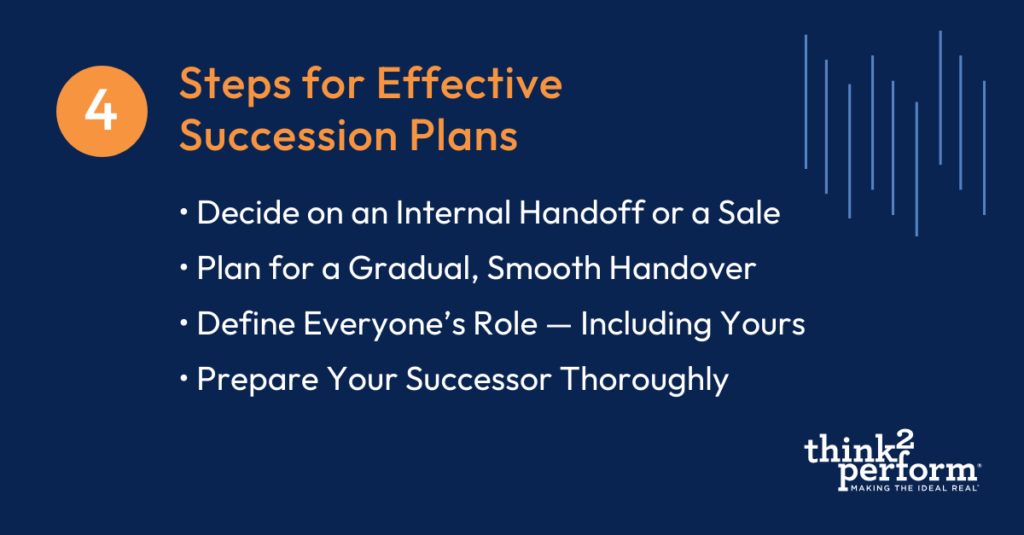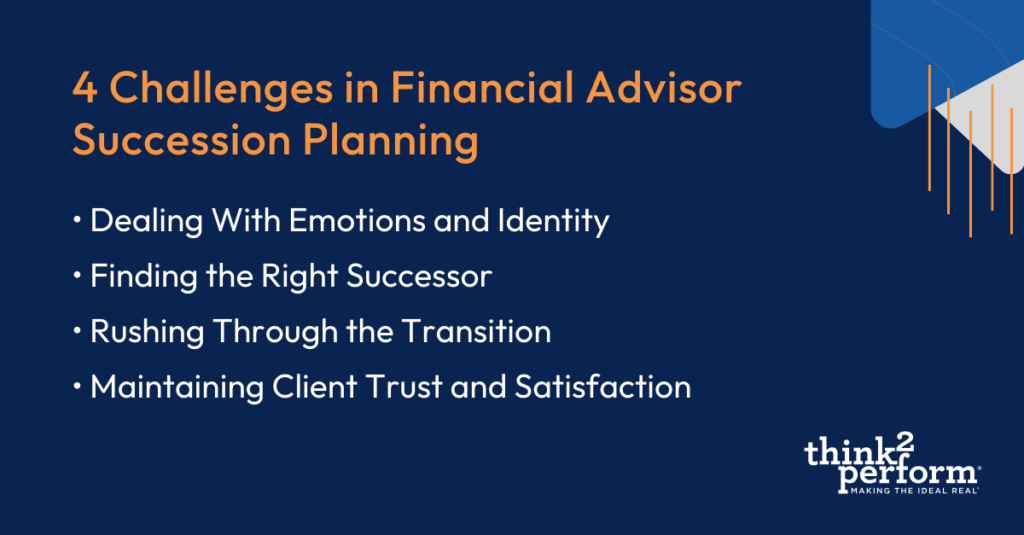Everybody needs to plan for their future. As financial advisors, you help clients achieve their financial goals. But when you own a financial services firm, you also need to plan for the future of your business. Succession planning for financial advisors is just as important as the steps you took to build the business.
The good news is that nearly 65% of financial advisors surveyed by SmartAsset have succession plans in place. The bad news is that more than one-third of firms don’t have a formal plan. Effective succession planning takes time, whether you’re passing down the business, elevating an employee or selling to a third party. Every month or year that goes by without a plan means you’re missing out on securing your firm’s future — and reassuring your employees and clients.
Let’s look at why succession planning for financial advisors can be difficult, best practices for getting it right and why values are essential.

What Makes for a Good Succession Plan?
Succession planning shouldn’t be rushed or conducted by instinct. You need to dedicate time outside the day-to-day bustle to thinking deeply about when you want to retire, who can and should lead the firm, and how you’ll prepare them (and yourself) for this next phase.
Here are some of the steps involved in a financial advisor’s succession plan.
Decide on an Internal Handoff or a Sale
Every business needs to decide whether they’re handing things over to a family member, elevating a non-family employee, or selling to a third party. This decision is yours to make based on who’s willing to step up, their aptitude and values alignment, and their financial capability to buy you out.
“The nice thing about financial services businesses is there is a huge appetite for mergers and acquisitions,” says Victoria Michalski, senior vice president at think2perform. “So if they do decide to sell, they’re not going to have a lack of people looking to purchase their business.”
Because succession planning is a multiyear process, you can keep both options open. Develop your internal talent, but know you can sell should circumstances change.
Plan for a Gradual, Smooth Handover
While every business should have contingencies for the unexpected, a planned transition over several years is a best practice for the financial services industry. The incoming leader can grow into the role, and employees and clients benefit from continuity and stability. For example, a high-potential leader might need seasoning in the financial or executive aspects of the job. A gradual transition allows them to work on those skills under the watchful eye of the current leader in a supportive environment.
A gradual transition can also be helpful for a founder or owner who isn’t ready to simply step away. “Moving into a succession plan over time feels really good when the owner can retain some sort of meaningful role in the practice,” says Elena Beckius, senior vice president at think2perform.
Importantly, the CEO/owner has to understand that they’re ultimately giving up control. “The next phase is not for me, the founder, to define and create a vision for and direct — it’s for me to actually co-create with this team or this individual,” Elena says.
Define Everyone’s Role — Including Yours
Role definition is crucial for everyone involved in the transition. Ambiguity leads to conflict, hampers decision-making, and leaves employees, clients and prospects questioning the firm’s direction and who’s in charge.
When you have a clear road map for how succession will take place, employees feel reassured about the company’s path, and they know who’s in charge of what. Clients, meanwhile, don’t worry about whether they’ll have to find a new adviser or whether there will be drastic changes in their relationship with the firm.
Role clarity also empowers your successor to lead, knowing that you’re supporting them in their growth path. They can gradually take on certain responsibilities, like becoming a public face of the firm, while they develop in other areas, such as better understanding the financials.
Finally, role clarity helps the owner gradually step back from day-to-day management while finding whatever next role is right for them. Often, that role is as an advisor or chairman. Owners have “a lot of experience, they’ve seen a lot of these pitfalls, so they can provide a different kind of guidance,” says Alan Lennick, senior vice president at think2perform. While the new CEO needs to make the final decision, they benefit from the former leader’s institutional knowledge and wisdom.
Prepare Your Successor Thoroughly
One of the benefits of a lengthy succession plan is the opportunity to train and develop the incoming leader on everything related to running a business. The successor likely excels at client relationships, but they might need to develop in areas such as strategy, financials or leadership.
Emotional intelligence is another core component for successors to level up in. This is where “engaging a coach ends up being really significant for them… to help me prepare, not just the structure and the finances, but emotionally and mentally. ‘What’s going to be next?’” Alan says.
Leadership development should be a continuous process, whether you’re talking about values exercises, the 5 Levels of Leadership or any other approach, Victoria says. “You have to consistently revisit them, put them into practice,” she says, “because when you’re in the whirlwind of running a business, you don’t always remember, ‘I wonder what this person’s readiness level is to do this task?’”

4 Common Challenges in Financial Advisor Succession Planning
You might be surprised that some financial advisory owners struggle to put succession planning into place. After all, they’re in the business of helping others make plans. But that’s the point, Alan says. “The first hurdle to get over is the difference between being able to give somebody advice on how to prepare for retirement and taking the advice yourself to prepare for your own retirement,” he says.
When an owner or CEO needs help getting started with succession planning, a coach can be especially helpful. “It’s out there that I’m going to want to deal with my succession planning,” Alan says. “I need somebody to work with to help me prepare — not just the structure and the finances, but emotionally and mentally, what’s going to be next?”
Here are some of the common challenges for financial services firms with succession planning.
Dealing With Emotions and Identity
It’s no secret that business owners across sectors identify strongly with their company. Retirement planning is much more than a transaction.
“My own father was a small-business owner,” Elena says. “And I think he delayed his retirement longer than he probably should have because he just wanted to avoid that next phase of life — not because it was bad, but just because this is who he was.”
If you’re struggling to accept this change, consider your values. As think2perform consultant and Senior Vice President Ray Kelly said in an episode of Making the Ideal Real: “Legacy is more important than money to me. … And it’s not about leaving money behind for my family and friends. Can I actually give them something so they could make a difference with other people’s lives?”
Your motivation and top values might be different, but you can still live fully in your values even after leaving the business.
Finding the Right Successor
Succession planning should be a bolt-on to ongoing leadership development, especially if you’re looking to pass the firm on to a family member or an in-house employee. But if you’re not intentional about developing successors, you might lack the bench you need.
Elena advises talking with high-potentials about their professional goals. Share what you envision in their future — and whether that’s what they want. Not everyone desires to be a CEO, and that’s OK.
When you work with family members, this vetting process is especially important. “We really try and ascertain, what is the ‘why?’ behind them taking over the business,” Victoria says. “If they really do have the passion for the business and they really do want to take over the business, then what is needed to develop the person or persons?”
The pressures of being a family member in the business cut both ways, she adds. Family members might be concerned about coming into the business and earning everyone’s respect. Meanwhile, owners have to make sure they’re treating them the same as they would any employee.
“Do they have different rules? Do they have different vacation schedules? You can’t really do that when you’re running a business because people talk, and it’s not going to stay a secret for very long,” Victoria says.
Rushing Through the Transition
Succession planning isn’t something you can do in a few months or even a year. Many experts advise windows of anywhere from three to 10 years. A rushed process can lead to the wrong selection — someone not cut out for running a business, lacking the leadership skills or lacking alignment with the firm’s values.
Even when the right successor is picked, a rushed timeline can cause other problems. “It’s a lack of communication. It’s people not understanding where they feel fit in the plan,” Elena notes. “And sometimes we lose really, really great talent because they don’t understand the vision.”
Maintaining Client Trust and Satisfaction
Clients put great trust in their financial advisor and the practice they work for. Financial advisory firms must be careful to be transparent about a change in firm leadership, why it’s happening, and how the client will continue receiving the highest-quality service and expertise.
“It’s really important from a client experience and continuity standpoint that the outgoing leaders are in the practice and that they have a role,” Elena says. “That can be really helpful from a client experience standpoint.”
The Role of Values in Succession Planning
Values play a crucial role in succession planning, whether you’re promoting from within or selling to another firm. With internal successors, revisit the values exercise to see where you stand.
While values can stay consistent throughout a person’s life, values alignment can change based on the person’s role and responsibilities. “If your top value is family and how you define family as being there for X, Y, and Z,” Elena says, “Are you OK that that could shift for a period of time as you’re coming into this new role and leading the business? How is it going to affect your other values?”
Even if you’re selling the firm to an outside company, values still matter. Alan notes that the deciding factors for M&A often come down to the acquirer’s service model and client experience. You don’t need identical values, but they should have compatibility and alignment.
“Are they compatible in such a way that I, as the seller, am comfortable in where you’re coming from deep within you — in terms of what experience you’re going to give to the clients that I’ve worked with for years?” Alan says.
How to Communicate the Succession Plan
Communicating the plan is nearly as important as the plan itself. Here’s how to communicate to different stakeholder groups:
Your Potential Successor(s)
Once you’ve decided to begin the succession planning process, be clear with anyone you consider a high-potential leader, whether that’s family or someone else. Understand what they want out of their careers and whether that aligns with the demands of running a financial services business. Importantly, communicate about how they’ll need to grow professionally — and watch how they respond.
“If you don’t see them moving forward in some of these baby steps, or they don’t understand how to drive their own part of the book,” Victoria says, “I’d say those are some red flags.”
Clear, consistent communication will also ensure everyone knows where they stand, including any leaders in the firm who aren’t being considered as successors. Being direct and transparent can soften the blow and help them focus on what they want to do next with their career, either inside the firm or elsewhere.
Your Workforce
Even if you’re in the early stages of succession planning, communicate what you know and what to expect so your people can plan accordingly. Victoria notes that some of your staff will consider timing their own retirements to yours. If nothing else, clear communication helps employees feel like they have some measure of control over their future with the firm — and the agency to explore other options if necessary.
Your Clients
A leadership transition is a powerful opportunity to nurture trust in clients. As valuable as you are, the firm is what delivers the client experience and helps them achieve their financial goals. “It’s not just about me retiring,” Alan says, “it’s about putting something in place that’s going to work even better for you if I do this well.”
Succession planning for financial advisors is a vital stage of a business owner’s career, but like everything else in financial planning, your values can be your guide. Whether you’re transitioning your business to the next generation or an acquirer, the right plan can further your legacy and benefit your employees and clients for years to come.
“I want to feel really good that, if I run into a former client of mine at the grocery store someday,” Alan says, “I want them to say, oh, thank you so much for turning the business over to whomever I chose.”
Learn about how think2perform can help your business navigate succession planning and other changes through our leadership solutions, including professional coaching and business consulting.



